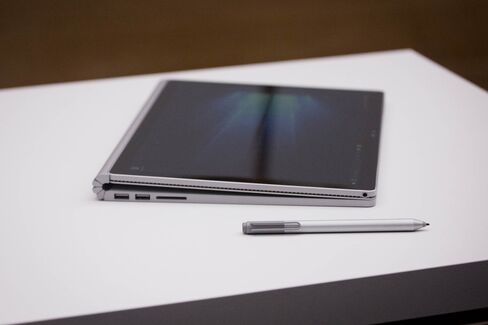Microsoft Corp. introduced its first-ever laptop, wading deeper into hardware to spur adoption of its Windows 10 operating system and crank up the competition with Apple Inc. and Google Inc.
The Surface Book laptop has a detachable screen, allowing it to be used like a tablet, and a battery that can last up to 12 hours, Microsoft said in a statement Tuesday. It is two times faster than Apple’s Macbook Pro, Panos Panay, who runs engineering for Microsoft, said at an event in New York. Prices start at $1,500 for the 13-inch laptop, which will go on sale this month. Panay also introduced three Lumia phones and a Surface Pro 4 tablet.
The success of Windows 10 is central to Chief Executive Officer Satya Nadella’s strategy of building an ecosystem of gadgets and cloud-based software and services that work together -- much the way Apple’s and Google’s do now. In releasing the new phones, tablet and laptop, the company is seeking to attract consumers and developers to the operating system, which works across a variety of devices from phones to game consoles. More than 110 million devices run the operating system, about two months after its release, the company said. Microsoft’s goal is to reach 1 billion in 2018.
Consumer Adoption
Microsoft’s underlying goal is use Windows 10 “to help drive further consumer demand and ideally start to change the perception of Microsoft as a ‘rounding error’ in the smartphone and tablet landscape,” Dan Ives, an analyst at FBR Capital Markets, said in a note. “It all comes down to consumer adoption.”

The Microsoft Corp. Surface Book laptop.
Photographer: John Taggart/Bloomberg
The Surface Book, which is geared at a wide range of users including game players, scientists, programmers and architects, is Microsoft’s attempt to compete with Apple in the high-margin, high-price personal-computer segment, Mike Silver, an analyst at Gartner, said in an interview. The laptop’s distinctive look, with the detachable screen and a flexible hinge, sets it apart from other devices that attempt to compete with Apple’s MacBooks, he said.
“I don’t think you’re going to mistake the Surface Book for any device on the market,” he said. “It’s really about taking a page from Apple and being able to provide the full experience, and I think that’s why they’re still doing phones.”
Microsoft shares closed little changed at $46.75 in New York, leaving the stock up less than 1 percent this year.
‘Pretty Cool’
The Surface Pro 4 tablet, 30 percent faster than the previous version, is 8.4 millimeters thick and comes with 1 terabyte of storage. The attached stylus comes in five colors and interchangeable tips to mimic a variety of writing tools, from ballpoint to felt-tip pens. The new product, which can be pre-ordered on Wednesday and available Oct. 26, starts at $899.
“We have competitors, you may have noticed, who are chasing it,” Panay said of the tablet. “It’s pretty cool.”
The Lumia 950 and 950 XL smartphones have two antennas to improve signal detection and allow users to glance at the locked screen for information without using the battery. The Lumia 950, priced at $549 and the XL, at $649, will be available in November. The company also introduced a lower-end Lumia 550 for $139.
“These are the new types of Windows devices and experiences that people will love,” Nadella said at the event.
Nokia Writedown
The handsets are the first released since the CEO said in July that Microsoft would write down almost the entire value of the acquired Nokia handset unit and fire about 7,800 people. Under the new plan, Microsoft will release fewer than 10 phones a year targeted in three categories: business phones, high-end models and value devices. Some analysts have said they are unclear whether the plan represents a retrenchment or the first stage in Microsoft’s complete withdrawal from the smartphone market over time.
“We are looking for clarity and understanding about the role of hardware and Microsoft,” Will Stofega, an analyst at IDC, said before the introduction of the new products. “Because if there’s any doubt, why would customers commit?”
Microsoft has described the new mobile-device plan as focusing not on selling as many phones as possible, but on a narrower set of scenarios in which it thinks it can win over customers. It’s a similar play to what Nadella has executed with the Surface gadgets, which now have reduced ambitions for market share but greater success in generating profit. The Surface currently generates more than $3.5 billion in revenue for the company a year, Terry Myerson, Microsoft’s vice president of Windows and devices, said Tuesday.
Windows-based tablets, including Surfaces, have gained share in the last year, rising to 8.7 percent in the second quarter, compared with 4.2 percent a year earlier, according to IDC. Microsoft hasn’t seen the same boost in phones, where Windows share rose to 2.6 percent from 2.5 percent.
‘Mixed Reality’
Microsoft also showed off its “mixed reality” games project in a HoloLens demonstration that uses holographic weapons. The company said it would deliver a development kit for the device to Windows 10 developers in the first quarter, priced at $3,000.
The company also unveiled a new version of its Band fitness device for the wrist, which went on sale in October 2014 to track and analyze health, fitness and sleep data. The Microsoft Band 2 has a curved screen and built-in GPS. Data is stored on the gadget rather than on a phone before being uploaded to the cloud. The Band 2, which works with Windows phones and Apple’s iPhones, costs $250.
No comments:
Post a Comment